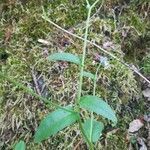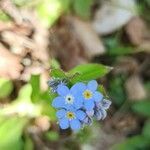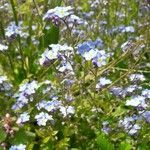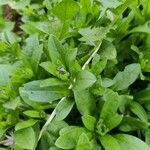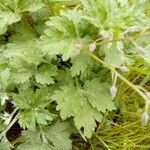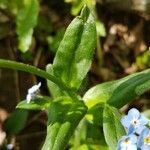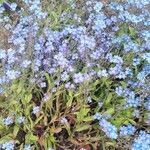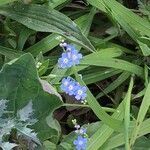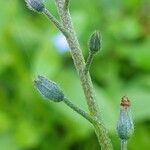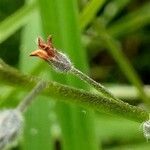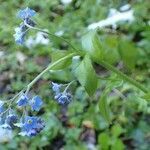Biennial to perennial; stem up to 50 cm, often much-branched, very leafy, with appressed hairs in inflorescence, otherwise with setiform hairs. Leaves c. 8 x 3 cm, broadly to narrowly ovate, or elliptical, the basal usually not distinctly petiolate. Pedicels up to 7(-15) mm, directed upwards. Calyx up to 5 mm in fruit, with short hooked hairs up to 0.2 mm, with linear to narrowly triangular teeth and rounded base, open, deciduous. Limb of corolla up to 8 mm in diameter but often smaller, flat, bright blue. Nutlets 1.7 x 1.2 mm, ovoid, acute, with rim; attachment-area very small.
Short-lived perennial to 5 dm; lvs oblong to lanceolate or spatulate, the larger 3–7 cm; racemes naked, seldom over 1 dm; fruiting pedicels 5–15 mm apart, ascending or spreading, to 9 mm; mature cal 4–5 mm, densely pubescent with hooked hairs, the lobes much longer than the tube; cor blue (white), salverform, the limb 5–8 mm wide; nutlets 1.5–2 mm; 2n=14–48. Native of Eurasia, occasionally escaped from cult. in our range. Apr.–Sept.
Perennial herb, 0.4-0.6 m high; hirsute. Leaves basally with blade elliptic, decurrent, up to 50 mm long, apex acute, base attenuate; upper leaves sessile, narrowly obovate, apex acute, base rounded to cordate, margins entire. Flowers: in scorpioid cymes, cymes usually forked; calyx 3-nerved, hairs hooked; corolla 3-4 mm long, bright blue, fornices yellow; Oct.-May.
Perennial herb, 0.4-0.6 m high; hirsute. Leaves: basal leaves with blade elliptic, base attenuate, apex acute, decurrent; upper leaves sessile, narrowly obovate, apex acute, margins entire. Flowers in scorpioid cymes, cymes usually forked. Calyx 3-nerved, hairs hooked. Corolla 3-4 mm long, bright blue, fornices yellow. Flowering time Sept.-Dec.
A small herb. It keeps growing from year to year. The stems are simple or branched and 15-50 cm high. The leaves at the base are 10-20 mm long by 1-10 mm wide. Leaves on the stems are 20-40 mm long by 1-15 mm wide.
Herb, up to 500 mm tall. Hairs on calyx hooked. Flowers blue.
